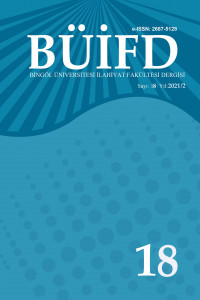Makaleler
Sayı Editör Kurulu






 0000-0002-8621-4469
0000-0002-8621-4469

Amaç ve Kapsam
BİNGÖL ÜNİVERSİTESİ İLAHİYAT FAKÜLTESİ DERGİSİ
Bingöl Üniversitesi İlahiyat Fakültesi bünyesinde yayın hayatına 2013 tarihinde başlayan Bingöl Üniversitesi İlahiyat Fakültesi Dergisi (BÜİFD), Haziran ve Aralık aylarında yılda iki sayı olarak 14. sayıdan itibaren elektronik olarak yayınlanan; akademik, ulusal ve uluslararası alan indeksli hakemli bir dergidir.
DOI: 10.34085/buifd.
Amaç:
BÜİFD, ulusal ve uluslararası düzeyde bilimsel niteliklere sahip çalışmaları yayımlayarak ilahiyat ve sosyal bilimler alanının bilgi birikimine katkıda bulunmayı amaçlamaktadır.
Derginin yayın dili Türkçedir. Ayrıca Arapça ve İngilizce bilimsel çalışmalar da yayımlanır.
Dergimiz 9. Sayı itibariyle TR DİZİN'de taranmaya başlamıştır.
Dergimiz 07.09.2020 tarihi itibariyle ERİH PLUS tarafından taranmaya başlanmıştır.
Dergimizde 06.04.2018 tarihinden itibaren İSNAD Atıf Siftemi kullanılmaktadır.
Dergimiz 13. sayıdan itibaren makaleler için DOI numarası verilmektedir.
BİNGÖL ÜNİVERSİTESİ İLAHİYAT FAKÜLTESİ DERGİSİ
Bingöl Üniversitesi İlahiyat Fakültesi bünyesinde yayın hayatına 2013 tarihinde başlayan Bingöl Üniversitesi İlahiyat Fakültesi Dergisi (BÜİFD), 25 Haziran ve 25 Aralık tarihlerinde yılda iki sayı olarak elektronik olarak yayımlanan akademik, ulusal ve hakemli bir dergidir.
Kapsam:
BÜİFD, ilahiyat ve sosyal bilimler alanında hazırlanan ve bu alanların temel problemlerini bilimsel bir bakış açısıyla ele alan, bu konuda çözüm önerileri getiren makaleler, çeviriler, olgu sunumlar, araştırma notları, tebliğ ve konferans metinleri, kitap, kongre, sempozyum ve panel tanıtımları, kitap ve tez değerlendirmeleri, literatür incelemeleri, sadeleştirmeler, bilimsel röportajlar, çağdaş ve geçmiş ilim adamlarıyla ilgili tanıtımlar vb. akademik çalışmalara yer verir.
Derginin yayın dili Türkçedir. Ayrıca Arapça ve İngilizce bilimsel çalışmalar da yayımlanır.
Dergimiz 9. Sayı itibariyle TR DİZİN'de taranmaya başlamıştır.
Dergimizde 06.04.2018 tarihinden itibaren İSNAD Atıf Siftemi kullanılmaktadır.
Dergimiz 14. sayıdan itibaren elektronik olarak yayınlanmaktadır.
Yazım Kuralları
YAZIM İLKE VE KURALLARI
1. Yayınlanmak üzere gönderilen çalışmalar, intihal tespitinde kullanılan özel bir program aracılığıyla intihal kontrolünden geçirilir.
2. Dergiye gönderilen çalışmalarda ulusal ve uluslararası geçerli etik kurallar ile araştırma ve yayın etiğine uyum şartı aranır. Ayrıca ICMJE (International Committee of Medcial Journal Editors) tavsiyeleri ile COPE (Committee on Publication Ethics)’un “Editör ve Yazarlar için Uluslararası Standartlar”ı dikkate alınmalıdır.
3. Çalışmalarda TDV İslam Ansiklopedisi'nin (DİA) imlâ kaideleri esas alınır.
Başlık:
4. Başlık içerikle uyumlu olmalı, koyu ve küçük harflerle Türkçe ve İngilizce olarak yazılmalıdır.
Yazar Bilgisi:
5. Yazarın adı-soyadı, görev yaptığı kurum, adresi, e-postası ve ORCID makale başlığının altında yer almalıdır.
Özet:
6. Her makalenin başında, konuyu kısa ve özet biçimde ifade eden, en az 150 en fazla 200 kelimeden oluşan ve 9 punto Palatino Linotype ile yazılan Türkçe ve İngilizce özet bulunmalıdır. Arapça ve Osmanlıca özetler 13 punto olmalıdır. Özet içinde, yararlanılan kaynaklara, şekil ve çizelge numaralarına değinilmemelidir.
7. Özetin altında 5 sözcükten oluşan anahtar kelimeler verilmelidir. Özet ve anahtar kelimeler uluslararası standartlara uygun olmalıdır. Örnek: TR Dizin Anahtar Terimler Listesi, Medical Subject Headings, CAB Theasarus, JISCT, ERIC v.b. gibi kaynaklar kullanılabilir.
8. Anahtar kelimelerden bir satır sonra başlık, özet ve anahtar kelimelerin İngilizceleri de bulunmalıdır.
9. Özet kelimesi Öz, İngilizcesi Abstract şeklinde, Keywords ise bitişik yazılmalıdır.
Ana Metin:
10. Yazılar MS Word programında A4 boyutunda yazılmalıdır. Sayfa ölçüsü, yazı karakteri, satır aralığı paragraf aralığı ve girinti şu şekilde olmalıdır: Üst: 4 cm; Sol: 3 cm; Alt: 4 cm; Sağ: 3 cm; Karakter: Palatino Linotype (Öz: 9, ana metin: 10, dipnot: 8 punto); Satır aralığı: Tam, Değer: 14 nk (Dipnot: Tam, Değer 12 nk); Paragraf aralığı: önce: 0 nk, sonra: 3 nk (Dipnot: önce: 0 nk, sonra: 0 nk) kullanılmalıdır. Paragraf başlarında 0,5 cm girinti (Dipnot: Yok) olmalıdır.
11. Arapça ve Osmanlıca makalelerde Traditional Arabic yazı tipi (Özet: 13, ana metin: 14, dipnot: 12 punto) kullanılmalıdır. Satır aralığı: Tek (Dipnot: Birden çok, Değer: 0,8); Paragraf aralığı: önce: 0 nk; sonra: 3 nk (Dipnot: önce: 0 nk, sonra 0 nk) kullanılmalıdır. Paragraf başlarında 0,5 cm girinti (Dipnot: Yok) olmalıdır. Türkçe makalelerdeki Arapça ibarelerde ise Traditional Arabic yazı tipi (ana metin 14, dipnot 12 punto) kullanılmalıdır.
12. Metin içinde vurgulanması gereken kısımlar, eğik harflerle yazılmalıdır. Koyu (bold) ya da altı çizili yazılmamalıdır.
13. Metin içinde başlıklar, ara başlıklar ve numaralandırmalar gibi birimlerin hiçbirinde otomatik başlıklandırma ve numaralandırma yapılmamalıdır. Tamamı normal yazı tipi ile yazılmalıdır.
Bölüm Başlıkları:
14. Makalede, düzenli bir bilgi aktarımı sağlamak üzere harf kullanmadan başlıklar numaralandırılabilir ya da ana, ara ve alt başlıklar şeklinde kullanılabilir. Birincil (ana) başlıklar koyu; ikincil (ara) başlıklar koyu ve italik; üçüncül (alt) başlıklar sadece italik yazılmalıdır.
Tablolar, Şekiller ve Resimler:
15. Varsa yazıdaki tablo, grafik, resim vb. nesnelerin sayfa düzeni genişliği olan 12x18 cm ebadını taşmaması gerekir.
16. Tablo ve şekillerin numarası ve başlığı bulunmalı ve altta ortalanmış olmalıdır. Başlıklar her sözcüğün ilk harfi büyük olmak üzere italik yazılmalıdır. Tablolar metin içinde bulunması gereken yerlerde olmalıdır. Şekiller ise siyah beyaz baskıya uygun hazırlanmalıdır.
17. Şekil, çizelge ve resimler toplam 10 sayfayı (yazının üçte birini) aşmamalıdır.
18. Çeviri, sadeleştirme ve transkripsiyon yazılarına orijinal metinlerin fotokopileri veya PDF formatı eklenmelidir. Ayrıca kitap tanıtım ve değerlendirmelerine kitap kapak resmi JPEG formatında eklenmelidir.
19. Dergiye gönderilen yazıların hacmi kaynakça ve dipnotlarla birlikte 8000 kelimeyi geçmemelidir. Herhangi bir yazının hacminin bu üst sınırı aşması durumunda, editörün vereceği karar geçerlidir.
20. Dipnot kullanımında yararlanılan kaynaklar ilk geçtiği yerde tam künyesi ile sonraki yerlerde ise uygun biçimde kısaltılarak verilmeli ve ayrıca çalışmanın sonuna kaynak gösterimine uygun olarak kaynakça eklenmelidir.
21. Dipnotlar sayfa altında baştan sona sıralı numara sistemine göre düzenlenmeli ve İSNAD Atıf Sistemi dipnot gösterme usullerine uyulmalıdır.
22. Arapça eser isimlerinde, birinci kelimenin ve özel isimlerin baş harfleri büyük, diğerleri küçük harflerle yazılmalıdır. Farsça, İngilizce, vb. diğer yabancı dillerdeki ve Osmanlı Türkçesi ile yazılan eser adlarının her kelimesinin baş harfleri büyük olmalıdır. Birden çok yazarı ve hazırlayanı olan eserlerde her şahıs isminden sonra virgül konmalıdır.
23. Âyetler italik karakterle yazılmalı, referansı (sûre adı sûre no/âyet no) sırasına göre verilmelidir. Örnek: el-Bakara 2/10.
24. Hadis kitaplarında, ilgili eserin hadis alanında meşhur olan referans yöntemi kullanılmalıdır. Örnek: Buharî, “İman”, 1.
25. İnternet kaynaklarında yararlanıldığı tarih belirtilmelidir.
26. Dipnot referans numaraları noktalama işaretlerinden sonra konulmalıdır.
27. Dergiye gönderilen çalışmaların sonunda “Kaynakça”sı bulunmalı, kaynaklar Latin Alfabesi ile yazılmış olmalı ve ulaşılabilirliğine özen gösterilmelidir.
28. Kaynakça yazarın soyadına göre alfabetik olarak düzenlenmelidir.
29. Dipnot ve kaynakça gösteriminde İSNAD Atıf Sistemi kullanılmalıdır.
Etik İlkeler ve Yayın Politikası
ETİK KURALLAR
Dergimizde yayımlanan çalışmalarda ulusal ve uluslararası geçerli etik kurallar ile araştırma ve yayın etiğine uyum şartı aranır. Bu yüzden dergimize gönderilen çalışmalarda yazarlarca, hakemlik sürecinde hakemlerce ve yönetimde editörlerce ICMJE (International Committee of Medcial Journal Editors) tavsiyeleri ile COPE (Committee on Publication Ethics)’un “Editör ve Yazarlar için Uluslararası Standartlar”ı dikkate alınmalıdır.
YAZARLAR
Sosyal Bilimler Alanında yapılan anket, görüşme vb. etik kurul belgeleri için aşağıdaki zorunlu belgelerin yüklenmesi gerekmektedir.
1. Bireylerden ölçek, anket, mülakat ve diğer veri toplama araçları kullanılarak veri toplanması gereken çalışmalar/makaleler için alınması zorunludur.
2. Yazarın bağlı olduğu üniversitenin Etik Kurul'undan onay almış olması gereklidir.
3. Etik kurul izni gerektiren çalışmalarda, izinle ilgili bilgiler (kurul adı, tarih ve sayı no) yöntem bölümünde ve ayrıca makale ilk/son sayfasında yer verilmelidir.
4. Olgu sunumlarında, bilgilendirilmiş gönüllü olur/onam formunun imzalatıldığına dair bilgiye makalede yer verilmesi gereklidir.
AYRICA;
Gönderilen makalenin akademik alanlara katkı sunacak nitelikte olması yazarın sorumluluğundadır.
Çalışmaların özgün olması ve araştırmaya dayalı olması gerekmektedir.
Her ne kadar intihal taraması dergi tarafından da yapılacaksa da akademik onursuzluk olan intihalin sonuçları tamamen yazara yönelecektir.
Makale aynı anda farklı dergilere gönderilmemelidir ve daha önce başka bir dergiye gönderilmiş olmamalıdır.
Makalede ismi yazılacak olan diğer yazarların araştırmaya katkı sağladığından emin olunmalıdır. Akademik katkısı olmayan kişilerin ilave yazar olarak gösterilmesi veya katkı sırası gözetilmeksizin, unvan, yaş ve cinsiyet gibi bilimdışı ölçütlerle yazar sıralaması yapılması bilim etiğine aykırıdır.
Dergiye makale gönderen yazarların derginin yayım ve yazım ilkelerini okuduğu ve kabul ettiği varsayılır ve yazarlar bu ilkelerde kendinden beklenenleri taahhüt etmiş sayılmaktadır.
Atıflar ve kaynakça gösterimi eksiksiz olmalıdır.
Yazar/lar, işlem süreçlerinde editörün istediği belge ve bilgileri zamanında sağlamaya özen göstermelidir.
Yazar/lar, hakem değerlendirmelerini uygun bir şekilde ve zamanında yapmalı ve gerekli değişiklerin yapıldığını sistem üzerinden belirtmelidir.
Yazar/lar, istenilen değişikleri akademik kurallar ve etik uygulamalar gereği yerine getirmeli, uygun bulmadığı değerlendirmeleri uygun bir dil ile sistem üzerinden belirtmelidir.
Yazar/lar, değerlendirme süreçlerindeki gizlilik ilkesine uygun hareket etmelidir.
Yazar/lar, çalışmalarının kabul edilmemesi durumunda editörden ilgili kararı isteme hakkına sahip oldukları gibi verilen kararın bu dergi ve sayı için tartışmaya açık olmadığını bilerek hareket etmelidir.
Yazar/lar, değerlendirme süreçlerinde gördükleri eksiklikler veya hatalı durumları zamanında editöre bildirmelidir.
Yazar/lar, değerlendirme kararlarına saygı duymalı ve sonuca verdikleri dönütlerde uygun bir dil kullanamaya özen göstermelidir.
Yazar/lar, derginin yazım, değerlendirme ve yayın kurallarını iyi okumalı ve bu kriterlere göre hareket etmelidir.
Yazar/lar, kabul edilmiş yayınları için, sıralama, sayı seçme gibi bir hakka sahip olmadıklarını bilmelidir. Yayın sırası veya sayı için ancak editöre görüş bildirebileceklerini bu görüşün yayın kurulu tarafından karara bağlanacağını bilerek hareket etmelidir.
Dergiye gönderilemiş bir makale gönderildiği süreç sonundaki dergide yayınlamaya özen gösterilir. Ancak yayın kurulu kararı gereği bu konuda karar Yayın kuruluna aittir.
Yazarlar, Yükseköğretim Kurulu’nca da belirtilen Bilimsel Araştırma ve Yayın Etiği Yönergesi’ni dikkate almalıdır.
EDİTÖRLER:
Editörler Ulakbim tarafından istenen ve aşağıda belirlenen kıstaslara dikkat edecektir.
1. Dergiyi geliştirme ve süreçleri iyi yönetmek için sürekli yenilikler arayışında olmalıdır.
2. Yazarların gönderilerinde tüm belge ve bilgilerin eksiksiz olduğunu kontrol etmelidir.
3. Yazarların süreci iyi kullanabilmesi için ayrıntılı gerekli bilgileri dergi sayfasında görünür biçimde deklare etmelidir.
4. Yenilenen süreçleri takip edip bunları dergi sayfasında yayınlamalıdır.
5. Diğer editörler ile sürekli iletişim halinde bulunmalıdır.
6. Gerektiği zaman yazarlardan gerekli bilgi ve belgeleri talep edebilmelidir.
7. Gönderilen çalışmanın Telif Hakkı Devir Formu ve Benzerlik Raporu, (gerekli ise) Etik İzin Belgesi'ni kontrol etmelidir.
8. Derginin amaç ve kapsamına uygun makaleleri kabul etmelidir.
9. Makalenin içeriğinde, araştırma ile ilgili olmayan atıfları kontrol edebilmelidir.
10. Çoklu yazarlarda makaleye katkı oranını belirten yazıyı talep etmelidir.
11. Etki kurul onayı gerektiren; canlı deneyleri, anket, görüşme vb. çalışmalarda Etik kurulun izin tarihlerini kontrol etmelidir.
12. Makalenin yöntem kısmında veri toplama başlangıç ve bitiş tarihlerinin olup olmadığını kontrol etmelidir.
13. Vaka çalışmalarında Aydınlatılmış onam belgelerinin alındığına dair imzalı belge alınmalıdır.
15. Makaleyi kesinlikle dergipark sistemi üzerinden almalıdır. mail aracılığıyla makale süreçlerini yönetmemelidir.
16. Hakemlere gerekli bilgi ve belgeleri sağlamalıdır.
17. Yazarlar ve hakemler ile olan iletişimde uygun bir dil kullanmalıdır.
18. Yazar ve Hakemlere yönelik aşağılayıcı bir üslup kullanmamalıdır.
19. Yazarların çalışması hakkında küçük düşürücü ifadeler kullanmamalıdır.
20. Yazar ve hakemlerin birbiri ile olan iletişimi dergipark mesajlar bölümünden, gizliliğe ve üsluba dikkat ederek sürdürmelidir.
21. Yazar veya hakemler birbirinin değerlendirmelerini kabul etmeyebilirler. Editör bu süreci uygun bir biçimde sistem üzerinden yürütmeye gayret etmeli ve tarafları birbiri ile doğrudan görüştürmekten kaçınmalıdır. Ancak zorunlu hallarde editör kurulu kararı ile yazar ve hakemin görüşmesini sağyalamalıdır.
22. Doğrudan yazarın şahsına yönelik eleştiri yapılmamalıdır. Değerlendirilen çalışmadır, yazarın kendisi değildir.
23. Hakemlerin gizliliğine dikkat edilmelidir.
24. Hakemlerin yazar ile çıkar çatışması olup olmadığını kontrol etmelidir.
25. Yazarın çalıştığı kurumdan hakem seçmemeye özen göstermelidir.
26. Hakemleri farklı iki kurumdan seçmeye özen göstermelidir.
27. Makalenin alanına göre hakem seçimini yapmalıdır.
28. Editörün izni olmadan hakemin çalışmayı başka biri ile paylaşması veya değerlendirme sürecine katması mümkün değildir. Editörü bu süreci kontrol etmeli ve gerektiğinde müdahale etmelidir.
29. Yazarın çalışmayı daha önce yayınlayıp yayınlamadığ ve bir çalışmanın parçası ise bunu açıkça beyan edip etmediğini kontrol etmelidir.
30. Değerlendirme süreçlerinin sağlıklı yürümesi için sistemin sürekli kontrol edilmesi gerekmektedir.
31. Zamanında dönütlerin sağlanması editörün sorumluluğundadır.
32. Gerektiği zaman hakem değişimine gitmelidir.
33. Bir makalenin reddine veya kabülüne ilişkin değerlendirmeyi hakemlerden gelen görüşlere göre belirlemelidir.
34. Editörler kendi makalelerini editörlük yaptıkları dergiye göndermekten imtina etmelidir. Ancak bu bir kural değildir. Eğer editör bir çalışmasını bulunduğu dergiye göndermek istiyorsa o sayı için editörlük görevini bir diğer editöre devretmelidir. Böylece değerlendirme süreçlerini görmemesi ve müdahale etmemesi sağlanmalıdır.
35. Editör hiç bir zaman hiç bir şekilde etki altında kalmamalıdır. Derginin sahibi, yayıncı ve diğer editörler gibi unsurların kararlarda etken olmasına izin vermemelidir.
36. Editör yazar veya hakemler ile hiç bir çıkar çatışması halinde bulunmamalıdır.
37. Editör yazarın atıf kısmına akademik zorunluluklar dışında bir öneride bulunmaktan kaçınmalıdır.
38. Editör dergiye gelecek olan şikayet ve önerileri zamanında cevaplamalı ve gerekli tedbirleri almalıdır.
39. Etik izin veya intihal şüphesi olan çalışmalar için gerekli belgeleri ivedilikle istemeli, isteklerin yerine getirilmemesi durumunda ilgili makaleyi iade etmelidir.
40. Dergiye gönderine çalşmanın tanımlamnası için çaba göstermelidir. (araştırma, deneme, olgu, kritik vb)
41. Bir makalenin karar süreci tamamen editöre aittir. Hakem değerlendirmeleri karar verme sürecinde etkin unsurlardır.
Ücret Politikası
Bingöl Üniversitesi İlahiyat Fakültesi Dergisi, yazarlardan makale değerlendirme ve yayın süreci için herhangi bir ücret talep etmemektedir. Yazarlara da herhangi bir ücret ödenmemektedir.




